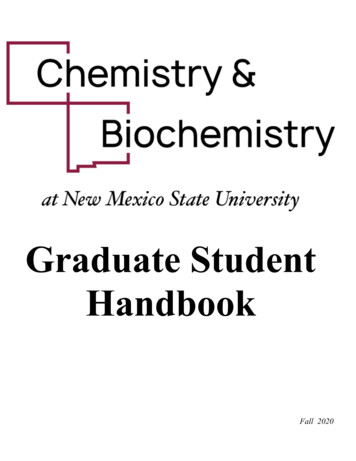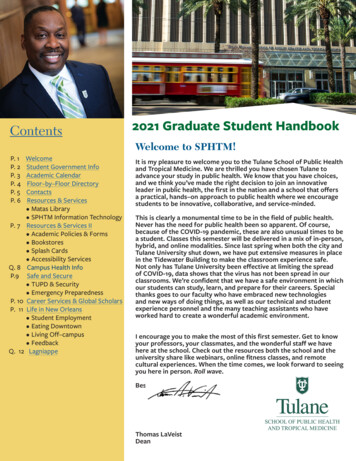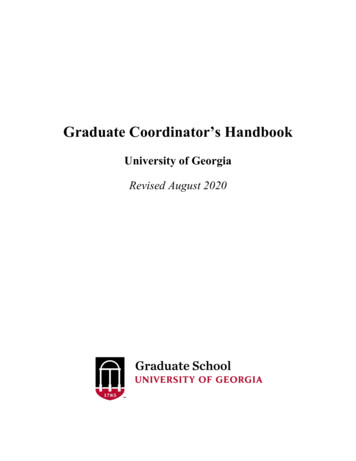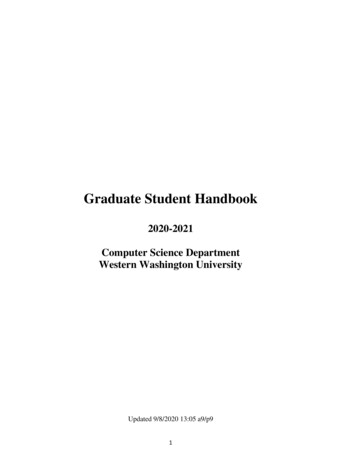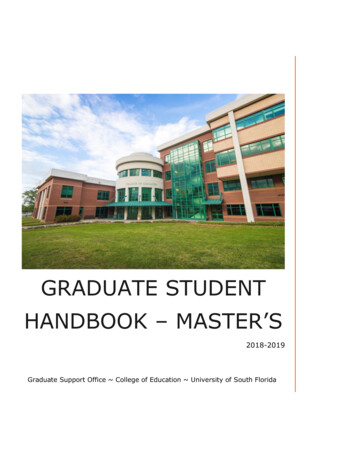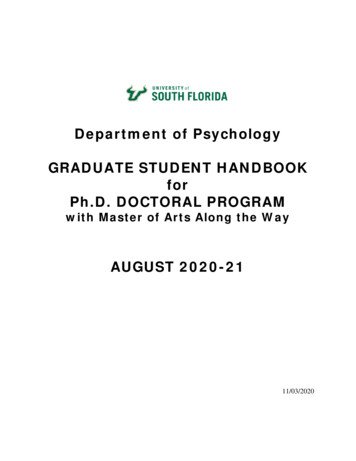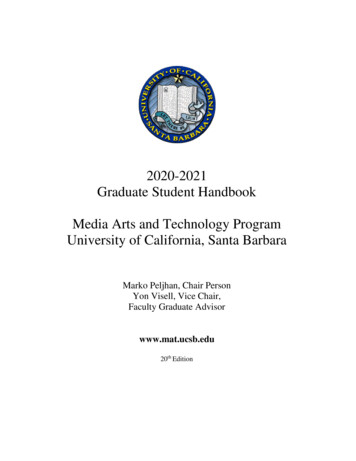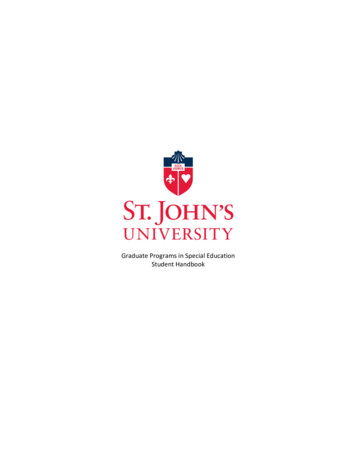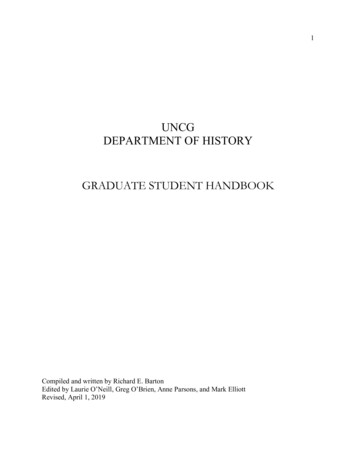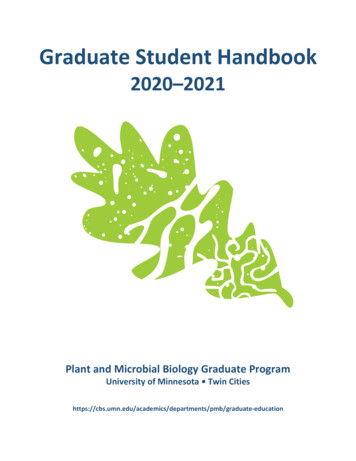
Transcription
Graduate Student Handbook2020–2021Plant and Microbial Biology Graduate ProgramUniversity of Minnesota Twin b/graduate-education
Plant and Microbial Biology Graduate ProgramGRADUATE STUDENT HANDBOOKThis handbook is meant to provide students with a primary resource of the requirements, expectations,and opportunities of the PMB Graduate Program. Use it as a reference as you progress through theprogram. To stay informed of expectations and opportunities, you also should read all emails you receivefrom the Director of Graduate Studies, the Graduate Program Coordinator, and the Graduate School.Table of contentsProgram overview . 1Suggestions for success . 1Key people and program resources . 2Calendars and notifications . 2Academic process: Doctor of Philosophy . 3Credit and course requirements . 4Research experience . 6Professional development . 7Teaching experience . 7Research presentations . 7Registration . 8Advisor and advisory committee. 11Advisory committee meetings/annual review . 13Preliminary written examination . 15Preliminary oral examination . 18Dissertation . 21Degree completion . 23Final oral examination . 25Academic process: Master of Science . 27Academic standards. 30Duration and time limits . 31Forms and signatures . 32Funding . 33Professional development . 36Summary: Key steps and milestones . 37Student and program activities . 38Key resources. 39Student rights and responsibilities . 43PMB Program Commitment to Diversity, Equity, and Inclusion . 46College of Biological Sciences Code of Conduct . 49Respectful and responsible conduct in the PMB Graduate Program . 50Best advising practices. 53Revised August 2020 by Sara Eliason, Peter Kennedy, and Peter TiffinPMB Graduate Student Handbook 2020–2021
Plant and Microbial Biology Graduate ProgramThe Plant and Microbial Biology (PMB) Graduate Program strives to provide outstanding interdisciplinaryeducation for careers in academia, industry, government, and public service. The program is committedto supporting diversity in both scientific pursuits and the community of people conducting that science.The graduate program seeks to recruit and train students from a wide variety of backgrounds and toprovide those students with: interdisciplinary educational, research, and professional development experiences; opportunities to work on a broad range of cutting-edge research topics in plant and microbialbiology; opportunities to conduct independent research and develop as innovative educators; opportunities to participate in the national and international plant and microbial biologyresearch community through seminars, colloquia, and conferences.The PMB program expects students to develop the conceptual understanding, analytical skills, andtechnical knowledge that allow those students to make important contributions to our understanding ofbiology and that lay the foundation for professional success.Suggestions for success You are here to learn. Take advantage of the many opportunities that the program andUniversity provide for your intellectual, professional, and personal development.Plan ahead. It is your responsibility to know the deadlines for key steps in your degree programand give yourself enough time to complete things well in advance of those dates.Seek to connect. Use your office and/or lab space to facilitate departmental interactions.Science is not a solitary pursuit; students who work from home seldom succeed.Build strong relationships. This includes with your thesis advisor, but also relationships withother professors, post-docs, and with your fellow graduate students.Keep up with the literature. This can be accomplished through readings, journal clubs, andseminars. Science changes rapidly, and you need to be at the forefront of knowledge.Aim to publish your work. Make a plan with your thesis advisor regarding publications and keepcommunication open.Write proposals and get feedback. Take advantage of fellowship and grant opportunities, bothat the University of Minnesota as well as from national and international sources.Become a member of a professional society. Attending annual meetings and giving talks orposters based on your research will help you develop a professional network.Embrace differences. The program includes a diversity of disciplines as well as scholars fromdifferent backgrounds and experiences. You will be a stronger scientist by learning how tocommunicate your science effectively to diverse audiences.Respect professors’ and staff members’ time. Professors and staff are here to work with andassist you, but remember they have other commitments. Whenever possible, give them enoughlead time to help you with questions or issues.Be mindful of your own wellbeing. Take care of your mental and physical health, and strive for ahealthy work-life balance. When you encounter difficulties, seek help. (See Key resources onpage 39.)PMB Graduate Student Handbook 2020–20211
Key people and program resourcesACADEMIC PROCESS, RESOURCES, SUPPORT, FUNDING, ETC.Dr. Peter KennedyDirector of Graduate Studies (DGS)kennedyp@umn.edu 612.624.8519Dr. Candice HirschAssociate Director of Graduate Studies (ADGS)cnhirsch@umn.edu 612.301.9522Sara EliasonGraduate Program Coordinator (GPC)140 Gortnerseliason@umn.edu 612.625.4222NOTE: The program DGS and GPCmaintain an open-door policy forstudents to discuss issues that mayarise with advisors, coworkers,peers, staff, research, courses,funding, degree progress, etc.Contact them or stop by theiroffices any time.PHYTOGRADS – PMB GRADUATE STUDENT ORGANIZATIONKelsey PetersonPh.D. student and Phytograds presidentpet02786@umn.eduHUMAN RESOURCES OFFICE—IN SNYDER HALLKelsey CookGraduate assistant appointmentscookx632@umn.eduOFFICES, KEYS, AND MAIL Office / bench space is generally provided by your advisor. For students who have not yetidentified an advisor, the program will identify office space. To obtain access to the building, office, and lab you should talk with your advisor or the GPC. Your mailbox location depends on the building in which your office is located, ask your advisor.COMPUTERS AND PRINTING Computer and general IT help: contact help@umn.edu and check https://it.umn.edu/. You may be eligible for a graduate assistant computer subsidy. For details, faculty-staff/rlt/computer-subsidy.(If you use the subsidy, the computer is the property of the University and must remain at theUniversity when you leave.) Poster printing is available through the University Imaging Center: http://uic.umn.edu/. General printing: Check with your advisor and the building where your office is located.Calendars and notifications The general academic calendar with dates of registration, add/drop deadlines, finals, andholidays for each semester is posted online at https://onestop.umn.edu/dates-and-deadlines.The graduate student planning timeline and information is posted online nt-services-and-progress-gssp.PMB Graduate Student Handbook 2020–20212
Academic process: Doctor of PhilosophyIt typically takes five years of full-time work to earn a Ph.D. A general timeline of how students spendeach of the five years in the program: First year: Explore interests, develop knowledge, take courses, conduct preliminary research,and identify potential research projects that will form the basis of the dissertation.Second year: Complete courses, write research proposal, gain expertise in the research area,complete written preliminary exam, get started with dissertation research.Third year: Complete oral exam (by beginning of your fifth semester), devote an increasedamount of time to collecting data, analyzing data, interpreting results, and writing dissertation.Fourth year: Devote time to dissertation research and writing (and submitting) manuscripts,start thinking seriously about career paths following graduate school.Fifth year: Complete dissertation, make concrete plans for career path following graduation,graduate.All students must fulfill certain educational requirements: core courses supporting courses thesis credits research experience professional development teaching experienceThe sections in this handbook elaborate on these expectations, describe program and universityrequirements and deadlines, and provide information on resources to help you complete your degree.Most students are financially supported by a combination of fellowships, research assistantships, andteaching assistantships. These, too, are discussed in this handbook.PMB Graduate Student Handbook 2020–20213
CREDIT AND COURSE REQUIREMENTSStudents come into the program with diverse interests, backgrounds, and career goals. As such, you areable to tailor your course plan with the help of your major advisor and advisory committee. However, asa student earning a graduate degree in PMB, you are encouraged to advance your knowledge and gaincompetency in the broad spectrum of disciplines covered in the program. Course work is one way togain this competency.Credit requirements 54 credit hours total required 30 course credits– 9 credits of required courses– 21 credits of supporting courses, minimum 24 thesis credits Grades of S, C, or higher are required on all coursework. At least 20 credits must be from courses graded A-F. Two 4000-level courses are allowed. (For permission to take more than two 4000-levelcourses, confer with your advisor, committee, and the DGS.)DEGREE PLANYou will work with your advisor and committee members to develop a plan for the course work andthesis credits you will take. Once you have decided which courses you will take, you must submit theonline graduate student degree planner (“GPAS planner”). Access the planner through the “Academics”tab on MyU.DEADLINE: As a graduate student in Plant and Microbial Biology, you must submit yourGPAS planner early in your fourth semester, before you submit your writtenpreliminary exam.Your degree planner is an official document and can be viewed as a contract of courses that you havecommitted to take in order to obtain your degree. At the time of submission, a copy of the plan will alsobe sent to the GPC and the DGS.The PMB program recognizes that course availability and student needs change, so your course planmay change accordingly. When this happens, you do not need to submit a new GPAS planner, but youshould get approval from your advisor and advisory committee before deviating from your originalcourse plan.Please note: Do not submit the paper-based degree plan form to GSSP. PMB no longer uses this form.PMB Graduate Student Handbook 2020–20214
COURSESCore courses (9 credits)PMB 8081. Succeeding in Graduate School: Skills, Ethics, and Beyond (3 credits)Take this course in fall semester of your first year.PMB 8900, section 001. PMB Colloquium (1 credit)You must register for PMB 8900 section 001, the PMB seminar series, once, typically during yourfirst semester. In all subsequent semesters, you should attend the PMB Colloquium. Theopportunity to hear and meet invited speakers is an important component of the graduatestudent experience.PMB 8900, section 002. Itasca Orientation. (1 credit)Incoming students register for and attend the Itasca Orientation in August, prior to the fallsemester. The orientation is designed to foster interactions among students and faculty,introduce students to current research in the program, and provide guidance for a successful firstyear and graduate career.PMB 8900, section 003. PMB Graduate Student Seminar. (1 credit)Take this course in fall semester of your first year. The goal of this seminar is to foster interactionamong PMB students and highlight the breadth of research in plant and microbial biology. Fifthsemester students participate (but do not register) and give a seminar on their thesis proposal.PMB 8901. Preparation of Research Proposals. (2 credits)Take this course in the fall of your second year. The course prepares students for the preliminarywritten exam by providing instruction and feedback for writing an original research proposal. Inthis course, you will draft a research proposal, which you can then use as the basis for yourpreliminary written exam during spring of your second year.PMB 8994. Directed Research. (1 credit)Take this course in fall semester of your first year. Depending on your overall course load, youmay register for from 1 to 5 credits. The work for this course is conducted as part of yourrotations, or if you’ve already identified an advisor, under your advisors’ guidance.Supporting courses (21 credits)You must take at least 21 credits of supporting courses. There is a broad spectrum of courses thatmay be used to fulfill these 21 credits, including all 5000- or 8000-level courses offered with theAGRO, BIOC, BIOL, EEB, FNRM, GCD, GRAD, HORT, PLPA, PMB, and STAT prefixes. Courses with theBBE, CSCI, and LAAS prefix and some 4000-level courses in various programs may also be relevant.Other courses may be included with the approval of the advisor and DGS. A partial list of supportingcourses is available on the PMB Graduate Program website.NOTE: Transfer courses are allowed only if the courses were not applied toward completion ofanother degree. Credits taken as a master’s student and applied toward completion of amaster’s degree may not be applied towards a PMB doctoral degree.Thesis credits (24 credits)PMB 8888. Thesis Credits: Doctoral. (24 credits)Register for thesis credits in any semester. You must take at least 24 thesis credits.PMB Graduate Student Handbook 2020–20215
RESEARCH EXPERIENCEResearch experiences provide opportunities for you to identify a thesis project, an advisor, andcommittee members, as well as to develop research skills and gain exposure to a variety of researchtopics and techniques that will help you in advancing your research and academic goals.During your first semester in the PMB Ph.D. program, you must complete a research rotation oranother substantive activity that provides connections beyond your home lab. Both rotations andother activities for making connections outside of your advisor’s lab must be approved by the DGS.The process: Register for one credit of PMB 8994 Directed Research under the A-F grading option. The DGS is listed as the official instructor, but you will work with the lab(s) that fit your interests. By the fifth day of the semester, complete the PMB 8994 Directed Research plan form andsubmit to the GPC.RotationsIf you opt for rotations, plan to spend time in two labs (one may be in your home lab). Along withyour rotation mentors, you will define the nature and scope of the rotation activity at the outset.Rotation activities can be quite variable; some rotations focus on reading the scientific literature orlearning techniques, while others aim to accomplish particular experiments or analyses. Regardlessof the nature of the rotation, you are expected to engage in regularly scheduled activities, to discussprogress and problems with your mentors, and to evaluate results of the rotation.At the end of the semester, you will write a two-paragraph summary of each rotation and how theactivities completed link to your larger thesis goals. This document (no more than one page total)must be turned into the DGS by the last day of regular classes. The DGS will use that document anda one paragraph summary written by the faculty member(s) who are your mentor(s) for thesemester in order to determine your grade. You will be provided with the faculty feedback on yourrotation before the beginning of the following semester.If you choose to do rotations in order to find an advisor, be certain to ask the potential advisor ifthey are interested in having you as a student before you begin and how the rotation will contributeto their decision as to whether to serve as your advisor.Other activitiesIf you opt for another substantive opportunity outside of your home lab, plan the activity and getapproval from the DGS before commencing. This option is particularly geared for you if you enterthe PMB program having already identified your advisor, or identify an advisor soon after joining theprogram, and decide that formal rotation is not a valuable use of your or faculty members’ time.Because the per-week time commitment is likely less than that involved with a rotation, theexpectation may be that this other activity spans your entire first year.Ideas for other research skill activities include, but are not limited to: actively participate in one ormore faculty members’ lab/group meetings; participate in a formal journal club or discussion group;attend a regular seminar series in another program.PMB Graduate Student Handbook 2020–20216
PROFESSIONAL DEVELOPMENTProfessional development is central to graduate success. You develop professionally throughcourses, research, and interaction with others at the University. However, it also is valuable toengage in activities that are specifically aimed at professional development, and the PMB programrequires
PMB Graduate Student Handbook 2020–2021 2 Key people and program resources ACADEMIC PROCESS, RESOURCES, SUPPORT, FUNDING, ETC. Dr. Peter Kennedy Director of Graduate Studi
